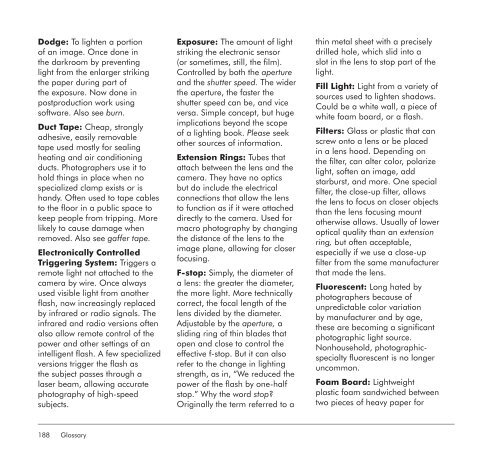Focus On Lighting Photos Focus on the Fundamentals.pdf
Create successful ePaper yourself
Turn your PDF publications into a flip-book with our unique Google optimized e-Paper software.
Dodge: To lighten a porti<strong>on</strong><br />
of an image. <str<strong>on</strong>g>On</str<strong>on</strong>g>ce d<strong>on</strong>e in<br />
<strong>the</strong> darkroom by preventing<br />
light from <strong>the</strong> enlarger striking<br />
<strong>the</strong> paper during part of<br />
<strong>the</strong> exposure. Now d<strong>on</strong>e in<br />
postproducti<strong>on</strong> work using<br />
software. Also see burn.<br />
Duct Tape: Cheap, str<strong>on</strong>gly<br />
adhesive, easily removable<br />
tape used mostly for sealing<br />
heating and air c<strong>on</strong>diti<strong>on</strong>ing<br />
ducts. Photographers use it to<br />
hold things in place when no<br />
specialized clamp exists or is<br />
handy. Often used to tape cables<br />
to <strong>the</strong> floor in a public space to<br />
keep people from tripping. More<br />
likely to cause damage when<br />
removed. Also see gaffer tape.<br />
Electr<strong>on</strong>ically C<strong>on</strong>trolled<br />
Triggering System: Triggers a<br />
remote light not attached to <strong>the</strong><br />
camera by wire. <str<strong>on</strong>g>On</str<strong>on</strong>g>ce always<br />
used visible light from ano<strong>the</strong>r<br />
flash, now increasingly replaced<br />
by infrared or radio signals. The<br />
infrared and radio versi<strong>on</strong>s often<br />
also allow remote c<strong>on</strong>trol of <strong>the</strong><br />
power and o<strong>the</strong>r settings of an<br />
intelligent flash. A few specialized<br />
versi<strong>on</strong>s trigger <strong>the</strong> flash as<br />
<strong>the</strong> subject passes through a<br />
laser beam, allowing accurate<br />
photography of high-speed<br />
subjects.<br />
188 Glossary<br />
Exposure: The amount of light<br />
striking <strong>the</strong> electr<strong>on</strong>ic sensor<br />
(or sometimes, still, <strong>the</strong> film).<br />
C<strong>on</strong>trolled by both <strong>the</strong> aperture<br />
and <strong>the</strong> shutter speed. The wider<br />
<strong>the</strong> aperture, <strong>the</strong> faster <strong>the</strong><br />
shutter speed can be, and vice<br />
versa. Simple c<strong>on</strong>cept, but huge<br />
implicati<strong>on</strong>s bey<strong>on</strong>d <strong>the</strong> scope<br />
of a lighting book. Please seek<br />
o<strong>the</strong>r sources of informati<strong>on</strong>.<br />
Extensi<strong>on</strong> Rings: Tubes that<br />
attach between <strong>the</strong> lens and <strong>the</strong><br />
camera. They have no optics<br />
but do include <strong>the</strong> electrical<br />
c<strong>on</strong>necti<strong>on</strong>s that allow <strong>the</strong> lens<br />
to functi<strong>on</strong> as if it were attached<br />
directly to <strong>the</strong> camera. Used for<br />
macro photography by changing<br />
<strong>the</strong> distance of <strong>the</strong> lens to <strong>the</strong><br />
image plane, allowing for closer<br />
focusing.<br />
F-stop: Simply, <strong>the</strong> diameter of<br />
a lens: <strong>the</strong> greater <strong>the</strong> diameter,<br />
<strong>the</strong> more light. More technically<br />
correct, <strong>the</strong> focal length of <strong>the</strong><br />
lens divided by <strong>the</strong> diameter.<br />
Adjustable by <strong>the</strong> aperture, a<br />
sliding ring of thin blades that<br />
open and close to c<strong>on</strong>trol <strong>the</strong><br />
effective f-stop. But it can also<br />
refer to <strong>the</strong> change in lighting<br />
strength, as in, “We reduced <strong>the</strong><br />
power of <strong>the</strong> flash by <strong>on</strong>e-half<br />
stop.” Why <strong>the</strong> word stop?<br />
Originally <strong>the</strong> term referred to a<br />
thin metal sheet with a precisely<br />
drilled hole, which slid into a<br />
slot in <strong>the</strong> lens to stop part of <strong>the</strong><br />
light.<br />
Fill Light: Light from a variety of<br />
sources used to lighten shadows.<br />
Could be a white wall, a piece of<br />
white foam board, or a flash.<br />
Filters: Glass or plastic that can<br />
screw <strong>on</strong>to a lens or be placed<br />
in a lens hood. Depending <strong>on</strong><br />
<strong>the</strong> filter, can alter color, polarize<br />
light, soften an image, add<br />
starburst, and more. <str<strong>on</strong>g>On</str<strong>on</strong>g>e special<br />
filter, <strong>the</strong> close-up filter, allows<br />
<strong>the</strong> lens to focus <strong>on</strong> closer objects<br />
than <strong>the</strong> lens focusing mount<br />
o<strong>the</strong>rwise allows. Usually of lower<br />
optical quality than an extensi<strong>on</strong><br />
ring, but often acceptable,<br />
especially if we use a close-up<br />
filter from <strong>the</strong> same manufacturer<br />
that made <strong>the</strong> lens.<br />
Fluorescent: L<strong>on</strong>g hated by<br />
photographers because of<br />
unpredictable color variati<strong>on</strong><br />
by manufacturer and by age,<br />
<strong>the</strong>se are becoming a significant<br />
photographic light source.<br />
N<strong>on</strong>household, photographicspecialty<br />
fluorescent is no l<strong>on</strong>ger<br />
uncomm<strong>on</strong>.<br />
Foam Board: Lightweight<br />
plastic foam sandwiched between<br />
two pieces of heavy paper for



